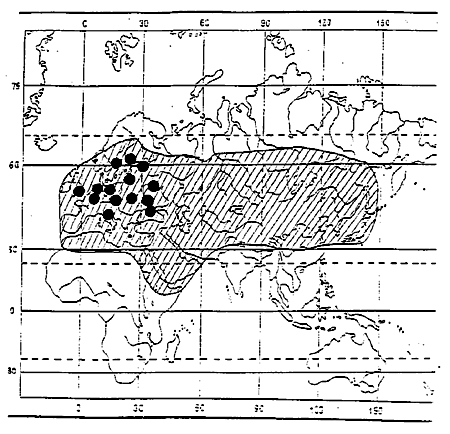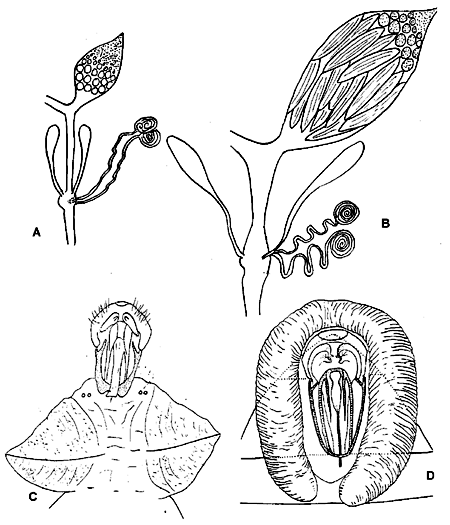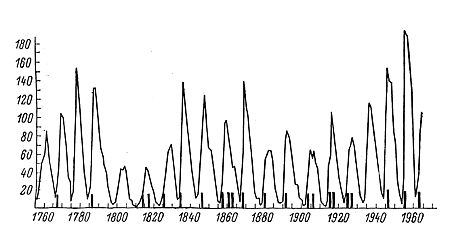
© 2000, Annual Reports of the Zoological Institute RAS.
Emilia P. Narchuk
Zoological Institute, Russian Academy of Sciences, Universitetskaya nab., 1, St. Petersburg, 199034, Russia
Mass occurrences of Thaumatomyia notata (Meigen, 1830) in houses is a well known phenomenon, recorded in the literature since 1832, when Jenyns (1832) in England described the phenomenon and named the fly Chlorops? laeta. A year later Zenker (1833) recorded mass occurrence of the fly in Germany and described a new genus and a new species as Thaumatomyia prodigiosa. The earliest notes on swarms of flies are referred to 1736, 1766, 1805 in England, 1807 in Germany, and 1812 in Poland, but flies were not given a scientific name. Publications on mass occurrences of this fly periodically appear in the entomological literature up to now. There are more than 100 publications on the subject in my list. Literature sources are divided into 3 types. Most of them are short notes describing one case of mass occurrence and are published in agricultural or local natural, more rarely in medical magazines. Another type of publications are short notes in biological, zoological or medical manuals, e.g. Brem's book. A few authors (Weyenberg, 1871; Letzner, 1873; Rhe, 1927; Hase, 1929; Rozsypal, 1930; Uhlmann, 1930; Lindner, 1931) overviewed separate cases. Tsygankov (1931) is the only author, who described some cases of mass occurrences of the fly in Russia, in suburbs of Moscow and Vladikavkaz. I had opportunities to observe swarms of the fly in the vicinity of Moscow in 1954 and near St. Petersburg in 1956 and 1997.
The Chloropid fly from mass occurrences in houses was named by many generic names: Chlorops, Chloropisca, Thaumatomyia and specific names: laeta Meigen, dydima Zettestedt, obscurella Zetterstedt, minuta Zetterstedt, hypostigma Meigen, notata Meigen, prodigiosa Zenker, copiosa Schiner, flavifrons Macquar, circumdata Meigen, ornata Meigen in different publications. Of them only prodigiosa, copiosa, circumdata and ornata are synonyms of Thaumatomyia notata, all other names appeared as a result of misidentification. Some of the synonymous names, such as prodigiosa, copiosa point to outbreak of the species, and the generic name Thaumatomyia means mysterious, enigmatic, amazing fly (in Greek).
The genus Thaumatomyia Zenker, 1833 includes 42 species in the world fauna. Of them 11 species are known in the Palaearctic Region, mass occurrences are recorded only for one - Th. notata. Also 11 species occur in the Nearctic Region, of them 2 species have Holarctic ranges. There is single note on mass occurrence of the Nearctic species Th. annulata Walker in Michigan in 1940 (Sabrosky, 1940).
Th. notata is a widespread species, known from the Palaearctic and adjacent parts of the Oriental and the Afrotropical Regions (Fig. 1). The species occurs nearly everywhere in the Palaearctic, except the northern part, where it is replaced by the Holarctic species Th. trifasciata Zetterstedt. The northern border of the range of Th. notata is situated on 66° N in the western part (in Fennoscandia) and on 63° N in the eastern part (in Yakutia) of the range. The species develops 3-4 generations per year depending on the latitude and hibernates as adult. Adults feed on different sugar liquids like nectar of flowers and as well as excretions of Chrysomelidae larvae (Pschorn-Walcher, 1956). Larvae are carnivorous and live in roots of plants (usually grasses) feeding on root aphids. All records on developing of the fly in stems of grasses are misinterpretations. The assumption of Mulyarskaya (1953) that larvae are saprophagous and develop in debris of bird nest is mistaken as well. In late summer and autumn, from the end of July through December depending on the latitude of locality, these small flies invaded in masses people's houses. This phenomenon occurs only in Europe, the northernmost record is Turku in Finland (Haartman, 1950), the southernmost one - Rimini in Italy (Binaghli, 1964) (Fig. 1). Enormous swarms of the fly appear usually near high buildings situated separately in vast parks with permanent grass lawns, in buildings of agricultural stations, in astronomic observatories. Some cases are described, when big swarms of the fly appeared as dark cloud near spires of churches or castles in the 19th century. Inhabitants confused it with smoke and sent for fire-brigade (Kiesenwetter, 1857; Letzner, 1873). It is noteworthy that swarms of the fly appear periodically in the same buildings. Barnes (1933) recorded swarms of the fly in buildings of the Rothamstedt experimental station in England in 1921-1922 and in 1931-1933. Tsygankov (1931) described swarm of the fly in buildings of the Timiryazev Agricultural Academy in Moscow 1921-1922 and I observed of swarm of the fly in the same locality in 1954. Sometimes swarms of flies in houses contain, except Th. notata, several specimens of another Chloropid fly Tricimba humeralis Loew, Madiza glabra Fallén from Milichiidae and parasitic Hymenoptera Stenomalus muscarum (Barnes, 1933; Zuska, 1966).

Fig. 1. Disrtibution range of Thaumatomyia notata Meigen (hatching) and known localities of mass occurrences of the species (filled circles).
Flies in the houses are passive, they usually sit on the ceiling. The number of flies is so high, that the ceiling looks dark. Waga (1848) counted 17.971.200 specimens of flies in one room. Hase (1929) recorded the collection of 40 liters of dead flies in one of the outbreaks, there being 360 flies per cubic centimeter. Sabrosky (1940) calculated that there were approximately 30 million individuals. Both sexes, males and females of Th. notata present in autumn in houses have enlarged abdomen (Fig. 2). The whole abdomen is completely filled with a fat body. Testes in males contain no ripe spermatozoa (Rozsypal, 1930). Ovaries are small and are on initial stages of development (Fig. 3, A, B). Flies which invaded heated houses cannot hibernate and die after 10-14 days, probably for loss moisture. Flies successfully hibernate out of doors in natural covers, such as holes, chinks, cracks, bird nests, coniferous cones, etc., and can endure of temperature up to -30 °C during winter. Th. notata were found in nests of Ardea cinerea, Buteo buteo, Lanius sp., Passer domesticus, P. montanus and P. hispaniolensis (Donistrop, 1935; Mulyarskaya, 1953; collections data). The flies appear early in spring, sometimes in March, usually in April.

Fig. 2. Thaumatomyia notata Meigen (after Lindner, 1931): A - female in autumn; B - female in spring
From other Palaearctic species Th. sulcifrons Becker besides Th. notata hibernates as adult. The range of Th. sulcifrons occupies the region of the Ancient Mediterranean. Mass occurrences of the species have not been recorded in the literature, but several specimens of the species sometimes accumulate in holes of rodents in deserts of Central Asia and also were found in houses in Ashkhabad in November (according the collection material of the Zoological Institute RAN in St. Petersburg).
Many authors, especially in the 19th century, considered mass occurrences of Th. notata in houses as some puzzle and even a mysterious phenomenon, a few presumed that flies are searching places for breeding. Now it is clear that flies invade people's houses occasionally in searching for place for overwintering. They often invade through windows situated on walls covered by ivy, wistaria, wild vine. However some questions remains unclear. These puzzles are: 1) why flies form so large swarm, 2) why flies often penetrate in the same buildings 2-3 years in succession, 3) why swarms of flies appear not every year, but periodically.
Males of Th. notata have a specific organ in the pregenital part of the abdomen. It consists of two vesicles usually pulled into the abdomen. These vesicles appear as dull-textured ovate organs at each side of the top of the abdomen (Fig. 3, C, D). Vesicles protrude during premating time as was observed by Steyskal (1945) and myself. It is not inconceivable that this organ produces specific aggregation pheromone in autumn. It may be also suggested that this pheromone can remain on walls of buildings, and flies are attracted to the same places where they have been in previous years. Unfortunately, histology of vesicles has not been investigated to date. Some other species of the genus Thaumatomyia and some species belonging to other genera of Chloropidae as Lasiambia Sabrosky and Polyodaspis Duda have analogous organs, their shape being different. Such organs are known in Th. glabra Meigen and Th. bistriata Walker as well, but these species do not hibernate as adults and swarms of these species are unknown.

Fig. 3. Thaumatomyia notata Meigen (A-C) and Th. glabra Meigen (D). A - ovary in summer in period of oviposition, B - ovary of hibernating female in autumn, C, D - top of male abdomen with protruded vesicles.

Fig. 4. Solar activity (ordinate - Wolf's number) and years with mass occurences of Thaumatomyia notata Meigen (black columns). Solar activity after Vitinsky, 1973
Periodical outbreaks of some insects, which are pest of agriculture or forestry are well known and have been studied for a long time. A number of theories were proposed for outbreaks: bioclimatic, trophic, parasitic and synthetical ones. The latter divides all factors into modified, mostly abiotic ones, not associated with abundance of population of insects and regulator ones being associated with abundance of population of insects and characteristic by reverse responses (Viktorov, 1967). All these theories have been proposed for phytophagous insects which are pests and whose outbreaks are easily recorded by damaged plants. There is a lucky opportunity in the case with Th. notata that mass occurrences of this carnivorous species is easily recorded because the fly penetrates into houses. Outbreaks of root aphids - prey of Th. notata have not been described in the literature as far as is known. An inceasing of abundance of root aphids have been recorded in years with warm and dry summer (Fedorenko, 1983). Parasitoids of Th. notata have been not studied.
Some authors related mass occurences of Th. notata in autumn to warm weather of preceding summer. Uhlmann (1930), who collected 54 cases of outbreaks of this species from 1812 through 1930 base on the literature data came to the conclusion that mass occurrences of the species were recorded in warm and dry years which were favorable to grapes. Beck (1990) titled his note on Th. notata "Die Last der Halmfliege nach warmen Sommern". There is something to this viewpoint, but what may be the reason of such association? Reactions of root-aphides and their predator Th. notata to warm and dry summer are similar and leads to intensification of reproduction ('koincidentia' according Thalenhorst, 1951). In addition, absence of precipitation during dry summer causes delay of emergence of flies from puparia, which occur in ground. As a rule, emergence of flies begins only after contact of puparia with drops of water, which is characteristic of many other Chloropidae. As a result puparia accumulate in ground and after autumnal rains mass emergence of flies comes into particular prominence. I propose to name the phenomenon as 'delayed emergence'.
I have succeed to collect data on mass occurrences of Th. notata during nearly two centuries from 1805 through 1997 based on the literature, collection's data in several European museums and my personal observations. Definite periodicity is clearly apparent in this long row of observations. Outbreaks repeat nearly every 11 years. Similar repetitions of outbreaks of some phytophagous insects are established. These cycles are considered to be associated with 11-years cycle of solar activities (Eidmann, 1925; Shcherbinovsky, 1964). Mass occurrences of Th. notata usually coincide with beginning of regular cycles of solar activities when Wolf's number increases (Fig. 4). These periods are characterized by more frequent eastern and meridional types of atmospherical circulation, when weather in Europe is warmer and dryer (Tyabin, 1957). Association of outbreak of carnivorous species with periodicity of the solar activities is recorded for the first time.
The studies were carried out with financial support of State Scientific-Technical Program "Biological Diversity" and the Russian Foundation for Basic Research (grants 99-04-49809 and 00-15-97826).
Barnes, H.F. 1933. Two further instances of flies swarming of Rothamsted experimental station with some references to this phenomenon. Entomologist's mon. Mag. 69: 230-232.
Beck, S. 1990. Die Last der Halmfliege nach warmen Sommern. Prakt. SchädlBekämpf. 42 (11): 185.
Binaghi, G. 1964. Caso di insediamento massivo di un Dittero Cloropide in und casa di abitazione della Rivera Liguri. Boll. Soc. ent. ital. 94 (3/4): 75-76.
Donistrop, H. S. 1935. The entomology of a heron's nest. Entomologist's Rec. J. Var. 47 (12):130.
Eidmann, H., 1933. Zur Kenntnis der Periodizität der Insektenepidemien. Z. angew. Ent. 18: 537-567.
Fedorenko, V. P. 1983. Seasonal changes of abundance of beet root aphid. In: Sistematika i ekologiya tlej - vreditelej rastenij [Systematics and ecology of aphids - pests of plants]. pp. 63-65. Riga. (In Russian).
Haartman, L.von. 1950. Mass occurence of Thaumatomyia notata Meig. Mem. Soc. Fauna Flora fenn. 25: 3-4.
Hase, A. 1929. Weitere Fälle von Massenauftreten der Fliege Cloropisca notata flavifrons Macq. (Chloropidae) und nähe verwandter Arten. Anz. Schädlingsk. 5:159-160.
Jenyns, L. 1832. Account of an extraordinary swarm of flies. Ann. Mag. nat. Hist. (ser. 1) 5: 302.
Kiesenwetter, E.A. 1857. Chlorops nasuta Meig. in grossen Schwärmen beobachtet. Berl. ent. Z. 1: 171.
Letzner, K.W. 1873. Schwärme der Chlorops ornata Meigen. Jber. schles. Ges. vaterl. Kult. 50: 193-199.
Lindner, E. 1931. Massenauftreten der Halmfliege Chloropisca notata. Naturw. Mschr. Heimat 44 (9): 257-262.
Mulayrskaya, L. V. 1953. Biozenosy ptichjikh gnezg [Biozenoses of bird nests]. Stalinabad. 85 pp.
Reh, L. 1927. Ungewöhnliches Masseverkommen von Fliegen in Häusern. Z. Desinfect. Gesundheitsw. 29 (6): 1-4.
Pschorn-Walcher, H. 1956. Chloropiden als Kostgänger bei Chrysomelidenlarven. Zool. Anz. 156 (11/12): 318-319.
Rozsypal, J. 1930. Ein Beitrag zur der Vergesellschaftung und Ueberwinterungsmöglich-keit der Imagenes bei den Chloropidae Z. wiss. InsektBiol. 25 (1-2): 1-13.
Sabrosky, C.W. 1940. Chlorops swarmings in houses. J. econ. Ent. 33 (6): 946-947.
Shcherbinovsky, N.S. 1964. Cyclic aktivity of sun and associated rhythmes of outbreak of organism. In: Zemlya i vselennaya [Earth and universe]. pp. 400-417. Ìoskva.
Steyskal, G. 1945. Behavior of Thaumatomyia (=Chloropisca) species (Diptera, Chloropidae). Bull. Brooklyn ent. Soc. 40 (2): 48.
Thalenhorst, W. 1951. Die Koinzidenz als gradologisches Problem. Z. angew. Ent. 32: 1- 38.
Tsygankov, S.K. 1931. Notes on mass occurences Chloropidae in houses. Zashch. Rast., Leningrad 7 (1-3) (1930): 163-164. (In Russian).
Tyabin, R. I. 1957. On problem on manifest of solar activity in the atmosphere of the earth. Problemy Arktiki 1: 67-72. (In Russian).
Vitinsky, Yu. I. 1973. Tsyklichnost' i prognozy solnechnoi aktivnosti [Cyclic recurrence and prognosis of solar activity]. Moskva. 278 pp. (In Russian.)
Uhlmann, H. 1930. Zur Gradation von Chloropisca notata Meig. In: 4.Wanderversam-mlung Deutscher Entomologen in Kiel. S. 70-76. Berlin-Dahlem.
Waga, A. 1848. Note sur une immense multiplication du Chlorops laeta aux environs de Varsovie. Revue zool., Paris (ser. 1): 49-54.
Weyenbergh, H. 1871. Ueber Fliegenschwärme. Verh. zool.-bot. Ges. Wien 21: 1201-1216.
Zenker, J.C. 1833. Miscellen. Notizen Geb. Nat. Heilk. Weimar 35: 344.
Zuska, J. 1966. Some instances of mass occurrence of Thaumatomyia notata (Meigen) (Diptera, Chloropidae). Acta ent. bohemoslov. 63: 88.